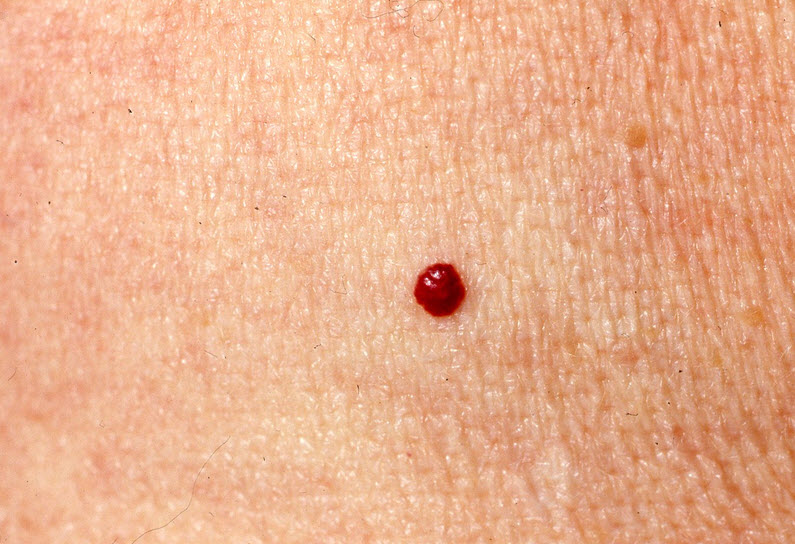 A cherry angioma is a common skin growth that can appear on any part of your body. It is also known as senile angioma or a Campbell de Morgan spot, a type of benign (not cancerous) skin growth. Cherry angiomas are common in people aged 30 and above. They result from abnormal growth of small blood vessels, which may get broken, giving them the characteristic red appearance. This skin growth should not make you worry unless it bleeds or changes its shape, color or size.
A cherry angioma is a common skin growth that can appear on any part of your body. It is also known as senile angioma or a Campbell de Morgan spot, a type of benign (not cancerous) skin growth. Cherry angiomas are common in people aged 30 and above. They result from abnormal growth of small blood vessels, which may get broken, giving them the characteristic red appearance. This skin growth should not make you worry unless it bleeds or changes its shape, color or size.
What Do Cherry Angiomas Look Like?
They are small, bright red, oval or circular skin growths. The common size is about a pinpoint or a dot and may appear smooth and flat on your skin or slightly raised. It can grow on your torso, shoulders and arms, or almost anywhere in the body, including the face, scalp, and neck.
Cherry angiomas often start to appear as small red dots. However, they can gradually enlarge to about a fourth of an inch or larger and may become thicker, sometimes like the shape of a dome.
Blood vessels making up angiomas lie close to the skin surface and if these are injured, cherry angiomas may bleed freely. This can occur if you scratch, rub or cut open cherry angiomas. Because of this, they must be removed only by doctors or trained medical providers.
Causes of Cherry Angiomas
The exact cause is not clear, but genetic factors are linked to their development. In rare cases, angiomas may develop in association with an internal malignancy.
Other factors associated with the formation of these benign skin growths may include exposure to chemicals, pregnancy, climate and dehydrated skin. Aging is another possible factor because they usually begin to develop when one reaches the age of 30. Cherry angiomas may increase in size and number as people age. Multiple angiomas occur in more than 70% of people who are at least 70 years old.
Treatment for Cherry Angiomas
Being enerally harmless, they do not need treatment unless there is bleeding. However, some people may opt to have them removed for cosmetic reasons. Consult a dermatologist about the appropriate method of removal. Some of the common procedures used to remove cherry angiomas include the following:
1. Electrocauterization
This involves burning cherry angiomas using electric current delivered by tiny probes. A grounding pad is placed on another part of the body as a shield to protect the rest of the body from electricity.
2. Cryotherapy
In this procedure, the cherry angiomas are frozen using liquid nitrogen, which can destroys them. This is a quick and easy procedure that requires only one session for treatment. Furthermore, there is a lower risk of infection compared to other procedures.
3. PDL
Pulsed dye laser (PDL) is another method used to remove cherry angiomas. It consists of a concentrated light that gives off heat to destroy cherry angiomas. This outpatient procedure is quick, but it can cause mild bruising that can last up to ten days.
4. Shave Excision
This procedure involves slicing away a cherry angioma in thin layers until it is gone. It is an alternative to invasive surgical procedures that involve cutting out the growths and using stitches to close the wound.
5. Electrosurgery
Electrosurgery is a minor surgical method that is most commonly used to remove cherry angiomas using an electric needle.
6. Natural Remedies
Natural remedies are usually slow in effect, but they also provide long-term benefits. Experts believe that a cherry angioma is a skin disorder related to dehydrated skin. Therefore, maintaining a healthy skin can help to prevent larger angiomas and the occurrence of this skin disorder. This may involve:
- Cleaning your skin naturally. Instead of using chemicals, make a mixture of fresh basil leaves and sandalwood to clear the clogging of skin pores due to excess oil produced by the sebaceous glands.
- Drinking lots of water to keep your body and skin fully hydrated.
- Taking vitamin supplements. Your skin needs vitamins A, vitamin E, and pantothenic acid to stay healthy. Add vitamin supplements to a healthy diet for effective treatment. Avoid eating junk foods.
- Limiting bromine intake and taking iodine supplements. It is believed that iodine deficiency or bromine toxicity may be potential factors associated with this skin condition.
Prognosis of Cherry Angiomas
They may increase in size and number as one becomes older. However, they are generally harmless and do not lead to cancer.
Note that it usually does not go away on its own. Unless it bleeds repeatedly or profusely when scratched or rubbed, there is no need to worry. Removal of cherry angiomas usually does not lead to scarring. Talk to your doctor about unusual changes in your skin growths to find out if they could be symptoms of another skin disorder or skin cancer.
